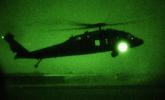 |
 |
Operation Marne Husky
Operation Marne Husky, a month-long operation subordinate to a new corps-level offensive Operation Phantom Strike, was launched by Multi-National Division-Center (MND-C) in August 2007. It targeted Sunni insurgents in the Tigris River Valley south of Baghdad that had been forced from safe havens in Arab Jabour and Salman Pak by U.S. operations earlier in the summer. The operational concept for Marne Husky differed significantly from those of Marne Torch I and Marne Avalanche; it relied on a series of air assaults across the southern belts of Baghdad to keep insurgents off-balance and to enhance the mobility of U.S. forces in an area in which canals and irrigation works limit movement and create opportunities for ambush and early warning.
Soldiers from the 4th Brigade Combat Team, 25th Infantry Divison, teamed up with aviators from 3rd Combat Aviation Brigade, 3rd Infantry Division, and conducted seven air assaults in the Tigris River Valley. This harrassed insurgents who fled the towns of Salman Pak and Arab Jabour in front of earlier U.S. offensives as they attempted to regroup in safe havens further away from Baghdad.
From Aug. 15 to Sept. 15, coalition forces captured 80 suspected insurgents and killed another 43. Pilots flew 420 hours during Marne Husky.
During Operation Marne Husky , U.S. forces saw the first real signs of sustainable Concerned Local Citizens (now called "Sons of Iraq") movements south of Baghdad, particularly in the al-Qaeda in Iraq (AQI) strongholds of Hawr Rajab and Arab Jabour.
In mid-September 2007, MND-C transitioned to Operation Marne Torch II.
